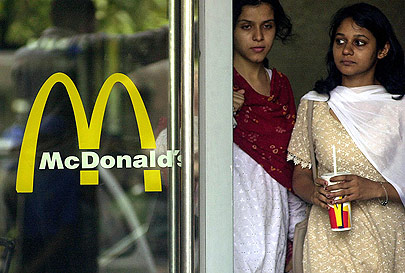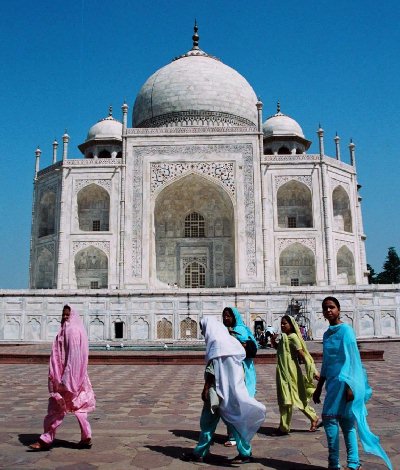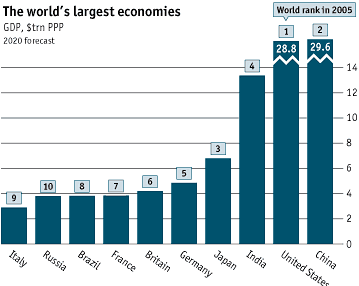|
|
|||||||||||||||||||||||||||||||
|
India's Challenging Economy
Rapid Economic Change and its Challenges Despite an unprecedented economic boom, India faces almost insurmoutable obstacles. Author says India's success in dealing with such problems may be a harbinger for the world's fate. Apr 15, 2007. Tulsi Tanti was so frustrated by recurring electricity blackouts that he set up two wind turbines on his property to ensure sufficient power supply to the family's textile mill in western India. That was in 1994. More than a decade later, Tanti's desperate fix has become a bonanza. His Suzlon Energy is a major global company that makes and installs turbines. With a market capitalization of $3.7 billion, it has $600 million in orders on hand from the U.S., China and Australia. "It's a wonderful story of hope out of what seemed to be an intractable problem and also a leap-frogging away from a mid-20th century reliance on fossil fuels to a 21st century energy model, which is extremely exciting," says New York-based author Mira Kamdar, 49, in Toronto recently to launch her new book Planet India. With Tanti's story Kamdar makes her case: the hope for India's future and that of the world, she argues, rests in large part on the ingenuity of the Indian people. "The scale of the problems we're facing – global warming, a transition away from an old world order with the decline of the influence of the U.S. and the rise of India and China, the stress on global resources, whether it's water or energy, and 3 billion people, if you put India and China together, coming online – all of this means what happens in India matters and will have a profound effect globally. "You can't have a country with 1.2 billion people and the fourth largest economy in the world, which is also a nuclear power by the way, veer off into some kind of social, environmental and political chaos without it having some impact on the rest of the world," says Kamdar, an associate fellow of the Asia Society. "If India can't make it with all of its advantages – functioning democracy, rule of law, big economy with world-class institutions – then what is the hope for the rest of us? As goes India, so goes the world. India's fate in some sense will be our own. "That's where the title Planet India comes from." There are two Indias, Kamdar suggests in her book. "The point isn't the new India does not exist. It does, and it is genuinely exciting and brimming with potential. However, the old India is hardly dead and gone. Indians freely talk about what they call the two Indias, often referring to the new India by its English name, India, and the old India by its Indian name, Bharat." As the U.S.-born daughter of an Indian father and Danish mother, Kamdar has been visiting India since 1960. Back then, India seemed to be changing almost imperceptibly, she says. "But almost seven years ago it really took off, especially in the urban areas. Today, India is experiencing this incredible transformation. I almost felt on a recent trip I was watching time-lapse photography, the changes were happening so fast. It's a historical moment of great promise and great peril, where India may make it or not." The India growth story, as reported by the Western media thus far, has been fairly one-sided, focusing on the country's meteoric economic rise while glossing over its myriad problems, says Kamdar whose first book, Motiba's Tattoos, chronicled her journey into her Indian family's past. "India has a cluster of challenges – one of the largest population in the world, 5.7 million people infected by the HIV virus, a desperate need for energy and water because it's adding 18 million people a year to its population, a huge Naxal (communist) movement with 20,000 people in uniform." The country also has 600 million people younger than 25, with raised aspirations, she adds. "If India can't find jobs for these people, to allow them to participate even in some minimal way in this economic growth story, it will have political chaos on its hands. So there is no ball it can afford to drop." If all that weren't enough, India must invent a new paradigm – inclusive capitalism – to move forward, she argues. That means not copying American-style "savage" capitalism, which exacerbates the gap between haves and have-nots and depends on disproportionate consumption and pollution, according to Kamdar. "The American system has proven it can create fast wealth, but it hasn't done it in a way that is environmentally sustainable or equitable."
"These are extraordinary individuals who are thinking outside the box, who understand they can't afford a failure of imagination, who are taking every one of the challenges India is facing and turning them into opportunity, who realize how important it is that India find its own way and not blindly imitate the western path to development – because it can't. "If India just develops and pollutes the environment, thinking we'll clean this up later, it will become unlivable. If India just creates a bunch of billionaires, thinking we'll worry about the poor later, it will degenerate into chaos. "It has to figure out how to make development equitable and sustainable now. The theme is opportunity in adversity." The Indian diaspora, 20 million people living primarily in the U.S., Canada, the U.K. and Australia, has a role to play – and many are using their wealth and expertise to forge partnerships with entrepreneurs and the Indian government. Kamdar calls India the new America – a land of opportunity. "The vibe is, anything's possible. In India you have a multicultural, multireligious democracy in a developing country that is an open and free society that has embraced capitalism. It's exciting and scary to think of the possibilities of that."
Social conformity. Traditional family roles. Sounds like the U.S. at the height of the feminist revolution in the early '70s. Women in India, a country that prides itself on being a traditional society, still face enormous pressure to conform to social mores. More often than not, the hurdle of conforming to traditional roles within families poses as much of a barrier to businesswomen in India as the still-too-thick glass ceiling at companies. Though women have made great strides in the corporate world in the last three decades, women from all income classes are still too often discouraged by family members from having careers that infringe too much on family life. However, in the last 30 years, a handful of businesswomen in India, including Lalita Gupte, Kalpana Morparia, Anu Aga, Kiran Mazumdar-Shaw and Simone Tata, have quietly broken through the barriers of social conformity--both at home and in the workplace--to become successful entrepreneurs and professionals. A few, like Indu Jain of privately held Bennett Coleman, India's biggest media house, have even reached billionaire status. Kiran Mazumdar-Shaw started one of India's first biotech companies, Biocon (otcbb: BCLTF - news - people ). Lalita Gupte and Kalpana Morparia (both were the only businesswomen in India who made our list of the World's Most Powerful Women), run India's second-largest bank, ICICI Bank (nyse: IBN - news - people ). Simone Tata built one of the first indigenous cosmetic brands, Lakme, now a unit of Hindustan Lever, which is owned by Unilever. And Anu Aga turned around an ailing company, the engineering firm Thermax Group (other-otc: THMFF - news - people ). Then there are two women who have had to display their leadership skills at a young age. Priya Paul became the president of Apeejay Surrendra Group at the age of 24 when her father was assassinated in 1990. Sulajja Firodia Motwani, managing director of Kinetic Motor, has ensured that in the past six years her company has collaborated with firms in Korea, Italy and Taiwan and has helped it grow from a niche moped maker to a manufacturer of a full range of two wheelers and auto components. Another sector in today's India that can boast of female leadership is technology. Since joining Microsoft India as its managing director in 2005, Neelam Dhawan has helped it grow 35%. Why are women doing so well in India? One reason: the country's long history of valuing education, so women who achieve academically are seen as smart and savvy. And it ordinarily doesn't hurt to come from money or an entrepreneurial family either, especially when you're trying to start a business. But three decades ago, when India's top women were just out in business, women were discouraged by society from pursuing careers. "In the 1970s, the odds were against them," says Bakul Dholakia, director of Asia's premier business school, the Indian Institute of Management, in Ahmedabad. "What really made them successful was their sheer determination to break through," adds Indira Parikh, a former dean at the Institute of Management and president of the Foundation for Liberal and Management Education in Pune, outside of Mumbai.
Prime Minister Manmohan Singh must quickly rebuild India's crumbling infrastructure or risk an economic flame-out Feb 25, 2007 A close look at India's dazzling and widely celebrated economic success of late reveals two Indias. There is the India that is casting off decades of post-independence socialism and a stubborn inferiority complex, now challenging China and Japan for global economic leadership by the mid-century, and making its mark with extraordinary GDP growth and daring foreign takeovers ranging from the world's biggest steel makers to the five-star Pierre Hotel in Manhattan. And there is the more familiar India, whose burgeoning middle-class population of about 300 million is matched by a similar number of impoverished citizens earning less than $1 (U.S.) a day – the world's largest poor population, in fact. A nation whose infrastructure of basic services – education, health care, electricity, navigable roads – remains shockingly primitive. The new India is described by popular Indian actor Amitabh Bachchan. "A pulsating, dynamic new India is emerging," the Bollywood star says in a TV ad for The Times of India. "An India whose faith in success is far greater than its fear of failure. An India that no longer boycotts foreign-made goods, but buys out the companies that make them instead." But the India of stereotype remains, the one described by Toronto Star foreign correspondent Gordon Sinclair in the 1940s of widespread destitution, and not only in the nation's 680,000 rural villages, where many homes are made with buffalo dung, tuberculosis is widespread, and the literacy rate is estimated at 33 per cent. (China's literacy rate is 90 per cent). In Bangalore, India's glittering information-technology capital, which has realistic aspirations to become a developing-world Silicon Valley, running water is available in most homes for just three hours a day. Even in India's big cities, electricity is only intermittently available. The economic potential of the world's second-largest country is undeniable. The Indian economy is super-charged, with annual gross domestic product growth of 8 per cent or more in each of the past three years. Not a few forecasters expect India's growth rate to surpass that of red-hot China this year. And using the United Nations GDP measure of purchasing power parity, which takes into account the local standard of living, India is destined soon to overtake Japan, as well, to become the world's third-largest economy, trailing only the U.S. and China. At home, the boosterish Times of India's "India Poised" posters are seen everywhere in the big cities. And abroad, India is promoting itself as a low-cost source of highly skilled labour, dispatching industrial-development ambassadors to sell the "New India" to bankers in Frankfurt, potential joint-venture corporate partners in London, and merger and acquisitions dealmakers in New York. Those envoys tell an accurate story of how economic reforms dating from 1991 have liberated India from the so-called "License Raj" of the post-colonial era, in which the country discouraged direct foreign investment under a centralized command economy. In the four decades following independence from Britain in 1947, local enterprises were designated as national champions in various sectors, protected from both domestic competition and foreign interlopers. Yet Delhi is in denial in imagining that India's torrid growth can continue unabated without drastic reforms. It's a topic not even raised within the current national coalition government of mainstream and Communist members, for fear of bringing the government down. The thinking among the more sanguine Indian policy makers is that the nation, with one of the youngest populations in the world, will cash in on a "demographic dividend." India's working population will continue to grow for decades, while that of China is forecast to decline. The result, in Delhi's view, will be relief from the current skills shortage, steadily rising GDP and tax revenues to pay for long-delayed infrastructure improvements, and a shift by the rural population – currently 60 per cent of Indians – from low-productivity work in farming to high-paying, skills-based jobs in urban centres. That scenario has a legion of disbelievers outside India. With characteristic condescension, The Economist asserted in a recent cover story that warns of India's current flirtation with a "hard landing" after years of allowing its economy to overheat, that "perhaps the only thing really growing faster in India than China is hype." That's a bit over-the-top for a nation that has endured decades of timidity and introspection following a long era of colonial exploitation. The local exuberance earlier this month was understandable over an Indian company's triumph in a bidding war for Corus Group PLC – an agglomeration of steel mills that includes the old British Steel, a relic of the empire whose chronic woes earned it a starring role in The Full Monty. The danger is a current disregard in Delhi over alarming signs of a potential economic flame-out, and longer term, of the urgent need for upgrading of schools, hospitals, roads and other crucial infrastructure, so that the anticipated exodus from rural areas will be one of educated students suited to well-paying jobs, and not a tide of unskilled refugees that would trigger an unemployment crisis. The current signals of an overheating economy include inflation running at 8 per cent, a four-fold increase in local stock-market values, a more than doubling of house prices in big cities, and an unprecedented borrowing binge by consumers and businesses alike – all the signs of a classic boom-bust scenario. India's central bank, the Reserve Bank of India, has been reluctant to remove the punch bowl from this party by raising interest rates. But India's debt-to-GDP ratio of 80 per cent, more than three times' that of China, and the highest among emerging-world economies, straitjackets Delhi in even its cursory efforts to invest in rural education, local clinics, power plants, modern highways and other infrastructure bottlenecks to sustained growth. About 90 per cent of the Indian workforce toils in the underground economy. Delhi's access to funds is unusually limited. In a nation of 1 billion people, only 35 million Indians pay income tax. (You read that right: 35 million people, not 35 per cent of Indians.) Even Cassandras aren't predicting an Argentina-style currency crisis or economic implosion for India. The country owes most of its mounting debt to itself; its external debt is low. India is blessed with $180 billion (U.S.) in foreign-currency reserves to ride out any currency crisis. And Delhi has pledged to increase investments in infrastructure to 8 per cent of GDP over the next five years, up from 4 per cent currently, which would approximate the infrastructure spending that China has been making for years. Yet India seeks to do the latter with public-private partnerships – that is, with a major infusion of foreign direct investment. That will be a challenge. While eager to partner with Indian firms in retail, IT and telecom ventures, foreigners are wary of Indian infrastructure projects. As the late Enron Corp. discovered with an ill-fated late-1990s Indian power-plant project, theft of electricity from local lines was rampant, and thousands of customers who balked at paying their utility bills were backed by the local state government. Many state governments are controlled by the Communist Party, which also props up the national coalition government of reform-minded Prime Minister Manmohan Singh. Singh finds his hands tied when, for instance, dealing with prospective foreign investors' concerns about archaic labour laws that prohibit companies from laying off more than 100 employees without government permission. Many Indian economists cite the sustained growth of Asian economies like Singapore, South Korea and Taiwan as a model, neglecting the fact those nations invested much more heavily in infrastructure than India has. And high-profile media reports of a recent Goldman Sachs forecast that India can sustain 8 per cent growth until 2020 usually left out the Goldman Sachs caveat that this economic miracle won't continue unless massive investments are made in infrastructure. India, which has had previous brushes with "economic miracles" only to see them fade, is indeed poised once again. But for what, exactly, will depend on the political will of its leaders.
|
|
||||||||||||||||||||||||||||||
|
Website Design + SEO by designSEO.ca ~ Owned + Edited by Suzanne MacNevin | |||||||||||||||||||||||||||||||

 Kamdar's book is based on her interviews with dozens of people, a fascinating cross-section of Indian society from college students to business leaders, politicians, entertainment figures and those working at the grassroots in social welfare.
Kamdar's book is based on her interviews with dozens of people, a fascinating cross-section of Indian society from college students to business leaders, politicians, entertainment figures and those working at the grassroots in social welfare.
 India's Most Powerful Businesswomen
India's Most Powerful Businesswomen
 India's rough passage to prosperity
India's rough passage to prosperity